|
The Making of Joss Papers |
|
 Excellent Work of the 5th Cyber-Island Photography Contest
Excellent Work of the 5th Cyber-Island Photography Contest
Photographer: He-Zhan Lin
Date and place photos were taken: 2008; Junan Township, Miaoli County
Burning joss papers, a special ritual of Han Chinese people in Taiwan, is commonly applied in temple events and festivals when people worship gods and ancestors or pay respect to spirits. The main purpose of burning joss papers is to communicate with the gods world or the spirits world. The sale of joss papers in this old shop is far less now, but the old master still adheres to quality and insists on using tin foil as the material to produce joss papers. Because the quality of his......
|
|
Read more...
|
|
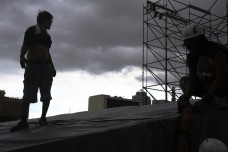 Excellent Work of the 5th Cyber-Island Photography Contest
Excellent Work of the 5th Cyber-Island Photography Contest
Photographer: U-Ru Zhang
Date and place photos were taken: 2008; Taipei
Amazing performances on the stage always pull the attention of audience. But, who has ever cared about the backstage crews who work behind the scene?
The theater is a space for collective cooperation. The professional backstage crews are the ones whose work allow the actors to concentrate on acting. Especially for the outdoor shows, rain or shine, all the crews......
|
|
Read more...
|
|
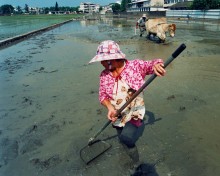 Excellent Work of the 5th Cyber-Island Photography Contest
Excellent Work of the 5th Cyber-Island Photography Contest
Photographer: Guo-Liang Wang
Date and place photos were taken: 2001; Siluo Township, Yunlin County
Every grain of rice in the bowl comes from many people’s labor. This is why stories of farmers always touch our hearts. Farmers raise ducks in their rice fields. The ducks eat weeds and pests and their feces become organic fertilizer for the rice plants. The rice plants grow better and are more resistant to pests and diseases. This is the rice that farmers wish for: the dock-cultivated-rice.
|
|
Read more...
|
|
Ancient coins excavated from the Bengang site |
|
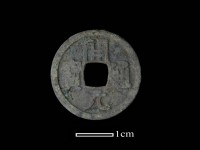 I. Bengang site
I. Bengang site
Bengang was the area that now includes Beigang Town in Yunlin County and Xingang Township in Chiayi County. It was one of the most important harbors in Taiwan during the Qing Dynasty and one of the first areas to be developed by Han Chinese settlers. Parts of Bengang were flooded several times by the rising waters of the Beigang River, resulting in many objects being buried and preserved. ...
|
|
Read more...
|
|
The Austronesians of Taiwan |
|
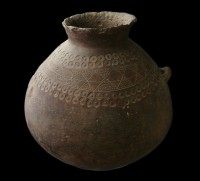 I. The Austronesian Peoples
I. The Austronesian Peoples
The Austronesian language family mainly refers to those peoples who inhabit the islands of the South Pacific. They number more than 250 million. Linguists discovered that there are a number of commonalities in the languages of these peoples and thus grouped them together into the same language family. Taiwan is located at the northernmost point of the Austronesian language family’s distribution which reaches east to Easter Island, south to New Zealand and west to Madagascar off the eastern coast of Africa. The Austronesians were able to spread across such a wide area with the use of boats, as they possessed outstanding navigation skills. ...
|
|
Read more...
|
|
|
Yami Traditional Fishing Boats |
|
I. Traditional Dwellings
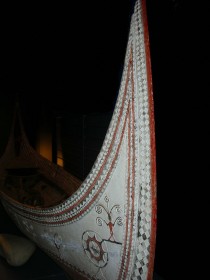 The traditional living and activity area of the Yami included a main house, a workhouse and a free-standing veranda. The main house is semi-subterranean, meaning that the entrance is below ground. This has the benefit of protection against strong winds. Before the foundation is laid, a drainage system is constructed to prevent flooding in heavy rain. The materials used in traditional dwellings include wood, stone, thatch, rattan, bamboo and reeds, etc. Different types of wood were used in different parts of the dwelling, and there were strict practices regarding the collection of timber. For example, when a tree was cut, it had to fall in an eastward or southward direction. The main post and thatch for the roof could only be obtained on an auspicious day and a pig had to be slaughtered as an offering to bless the home. ...
The traditional living and activity area of the Yami included a main house, a workhouse and a free-standing veranda. The main house is semi-subterranean, meaning that the entrance is below ground. This has the benefit of protection against strong winds. Before the foundation is laid, a drainage system is constructed to prevent flooding in heavy rain. The materials used in traditional dwellings include wood, stone, thatch, rattan, bamboo and reeds, etc. Different types of wood were used in different parts of the dwelling, and there were strict practices regarding the collection of timber. For example, when a tree was cut, it had to fall in an eastward or southward direction. The main post and thatch for the roof could only be obtained on an auspicious day and a pig had to be slaughtered as an offering to bless the home. ...
|
|
Read more...
|
|
|
<< Start < Prev 11 12 13 14 15 16 17 Next > End >>
|
|
Page 11 of 17 |